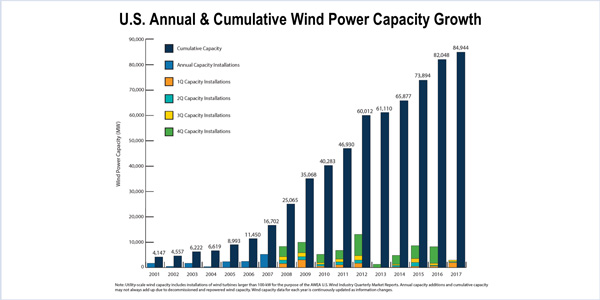By Rich Heidorn Jr.
The tax bill introduced by House Republicans on Thursday would trim the wind production tax credit by more than a third and eliminate the credit for electric vehicles while maintaining the tax credit for Southern Co.’s troubled Vogtle nuclear project.
The proposal would repeal the inflation adjustment for the PTC, effectively reducing the PTC from 2.3 cents/kWh in 2016 to 1.5 cents for projects begun after Nov. 2.
The American Wind Energy Association complained that the proposed Tax Cuts and Jobs Act “reneges” on the deal Congress made in 2015, which would phase out the PTC completely over five years.
AWEA CEO Tom Kiernan said the bill is “a retroactive tax hike” that would “pull the rug out from under 100,000 U.S. wind workers and 500 American factories, including some of the fastest growing jobs in the country.”
Under the 2015 legislation, wind projects that started construction in 2015 and 2016 receive the full PTC of 2.4 cents/kWh. Projects that begin construction in 2017 receive 80% of the credit, with those beginning in 2018 reduced to 60% and those in 2019 getting 40%. The credit would be eliminated for projects begun in 2020 and beyond.
Eliminating the inflation adjustment would boost tax receipts by $12.3 billion through 2027, according to a summary released by Republicans on the House Ways and Means Committee.
AWEA also said the law would unfairly change what constitutes the start of project construction. “Investors who put billions of dollars into factory orders and construction contracts cannot go back in time to meet the revised requirements,” it said.
Under current rules, a project is deemed to have commenced construction when it has passed a “physical work” test or shown that 5% or more of the total cost of the facility was paid or incurred. The physical work test is met by activities such as the beginning of excavation for turbines’ foundations or work on step-up transformers.
Developers are required to make “continuous progress” toward completion once construction has begun and must complete the project within four calendar years after the year in which it began construction. The new bill would eliminate the 5% “safe harbor,” disqualifying projects “unless there is a continuous program of construction.”
The wind industry is just one of the potential losers in the bill, which also eliminates the $7,500 tax credit for purchasers of electric vehicles. That would be more bad news for Tesla, which on Wednesday reported a $619 million quarterly loss and said it would not meet its goal of producing 5,000 Model 3 cars per week in 2017. Tesla shares dropped 6.8% Thursday.
The bill also would eliminate the permanent 10% investment tax credit for commercial-scale solar and geothermal power.
But there are also some energy winners.
The Treasury Department would forgo $1.2 billion through 2027 by “harmonizing” the expiration dates and phase-out schedules for ITCs on solar, geothermal, fuel cell, microturbines, combined heat and power system and small wind facilities.
In addition, the bill would remove a 2020 deadline for nuclear plants to claim the 1.8 cents/kWh nuclear production tax credit, a change needed to allow Southern’s overbudget and behind-schedule Vogtle Units 3 and 4 to claim it.
The credit applies to the first 6,000 MW of new nuclear capacity. Because the Vogtle project totals 2,200 MW, and South Carolina Electric & Gas’ V.C. Summer Units 2 and 3 have been canceled, it “will leave a significant amount of remaining capacity that future small modular or advanced reactor projects will be able to access,” the Nuclear Energy Institute said.




